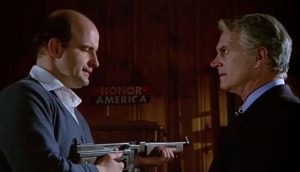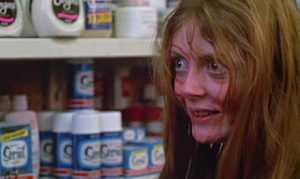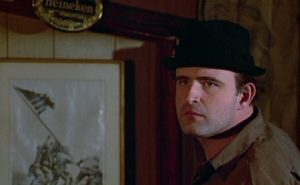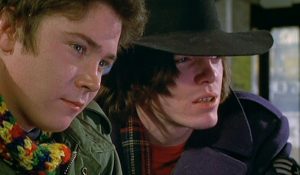
During a screening of “Joe,” actor Peter Boyle was outraged to discover the audience hooting and hollering as his titular character mowed down hippies with a shotgun. He vowed to never partake in another film that showcased violence from that point on, though he’d go against that just a few years later with “Crazy Joe” (no relation) and “Taxi Driver.” Still, the reason for his lividness is justified: the audience shouldn’t have been cheering on Joe. Despite having the film named after him and even a theme song, he is not the hero. He’s not even the antihero. Joe Curran is symbolic of warped hatred and the dangerous power it wields.
“Joe” is a darkly satirical take on class warfare in the late sixties/early seventies. It subverts the theme by having the blue collar worker being the one manipulating the wealthy, but deep down it represents the true message guiding all of these films: all classes being influenced by their bigotry. The film shines a light into a world stricken with war, poverty, and hate. When one can’t lash out at the government that overseen the downfall, the mind converts its attention to an easier target. Said target is the manifestation of one’s personal irritation. For Joe Curran, that is hippies.

Hippies at the time represented a backlash to societal norms. They “disrespected” a generation that brought them up, viewing them as warmongers and emotionally stunted. On the flip side, the blue collar working generation viewed their hippie offspring as lazy and pedantic. This caused a variation of a civil war with feuding classes distracting themselves from the disparities of everyday life. It’s much easier to blame thy neighbor than to accept ones differences and work together for the greater good. After all, each class aspires for the same result: comfortable living. This is highlighted immediately as we see a drug dealer complaining to his rich girlfriend that, unlike her, he has to work for his fortunes. Joe Curran would later regurgitate this statement in similar fashion. The only difference is one has access to a respectable factory position while the other pries on the addicted in the streets. Instead of working together to discover the similarities amongst their differences, both parties fixate on their radical gap.
Said drug dealer is Frank Russo (Patrick McDermott) and he is partly responsible for the overdose of his girlfriend, Melissa Compton (Susan Sarandon in her first film role). Her father, Bill (Dennis Patrick), can’t stomach the thought that his daughter’s own free will led to her near-demise, instead targeting her dragooning beau. In a fit of rage, he kills the drug dealer, covering the murder up to clear his name. It’s not long until Joe discovers that the advertising executive put the boy six feet under and a hero worship is developed.

This is where the film gets interesting. Joe, the more slovenly of the two, is the mastermind behind the operation. He tricks the seemingly astute businessman into hunting down hippies in the name of justice, ridding the world of serial killers disguised as drug peddlers. He shrewdly pries on Bill’s emotions, convincing him the spark of delight he experienced in the murder was that of righteousness. On the contrary, it was a fleeting feeling of vengeance transposed upon fatherly instincts. Bill felt a brief sense of joy in the belief that he protected his daughter, not savagery. The second he realizes how severe his actions were, guilt overtook him.
Joe, a normally shortsighted individual, is able to grasp an ounce of intelligence thanks to his bigotry. His disdain for hippies overcomes his mental state, tricking him into thinking all of his shortcomings are the result of a differing generation. He secretes into a bar where he surrounds himself with fellow disgruntled workers, all of whom turn to the bottle for comfort. Their broken spirits are the result of a government that has cut them short, pigeonholing them into respectable but low-paying careers that doesn’t do their war services justice. When hippies begin to share their disdain, the blue collar workers snap back at those they perceive as draft dodgers. Who are they to complain about being screwed when they haven’t put in the effort?

For Joe, he blames his children’s negligence on the burgeoning hippie movement. He can’t comprehend that his simple-minded ways may be the cause of their rebellion. He can’t even fully comprehend the meaning of counterculture; the definition of ever-changing ideals in media having to be spoon-fed to him. Once that happens, he immediately latches onto this theory and labels it a disgrace. His
For as ambitious as “Joe” is, it is the victim of flimsy direction. John G. Avildsen, who would go on to direct such classics as “Rocky” & “The Karate Kid,” struggles to bring Norman Wexler’s sharp script to screen seamlessly. The production is rough around the edges, stiff direction resulting in scenes that meander for far too long. This sometimes works in the director’s favor, such as the awkward dinner scene involving the Currans & Comptons, which is imbued with deep-seated hatred that is downright unsettling. On other occasions, it results in sequences that lose their luster a bit, such as Melissa’s drug-infused haze of a trip through a convenience store that comes across as comical instead of insightful.

Avildsen’s true struggle is in handling actors. He would grow into this later on flawlessly, but at this point he was used to directing pornography, so his grasp on humanity was nil. Peter Boyle & Dennis Patrick pose no problems, seeing as how their acute sensibilities carried their performances and, ultimately, the message at hand. Yes, Boyle isn’t reigned in enough, his portrayal of Joe almost too sketch-like for its own good, but it falls in line with the satire well enough that it doesn’t sink the drama. It’s the younger cast, notably Susan Sarandon, who are hung out to dry; putting forth shaky performances that fail to capture the dissonance on display. It almost works in their favor, but Avildsen isn’t quite able to pinpoint the dissension.
Rocky direction aside (pardon the pun), “Joe” succeeds as a satire if not only for its determined script. The social commentary is rich and palpable, unfortunately still relevant to this day. The amusement its dark comedy extracts is that of fear, forcing the viewer to confront society’s bigotry and, quite possibly, their own. Some either missed the memo or scarily embraced the titular antagonist, rooting him on and welcoming a disturbingly violent finale with open arms. Then again, maybe that should be embraced. If anything, those who fall victim to Joe’s blanketed views only strengthen the message overall. Their celebration of bigotry isn’t the undoing of the film’s quality, but the catalyst for it. It prompts a conversation which was the point all along.
Final Rating: B+
